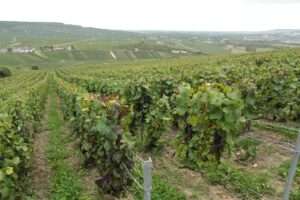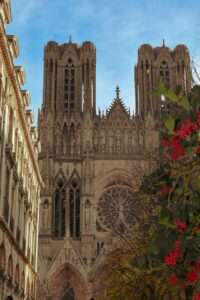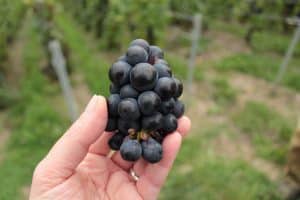|Champagne tours from Paris|
Paris to Champagne : Go on a private tour to discover the secrets of champagne, the king of wines! The region of Champagne is composed of 4 departments Aube, Ardennes, Haute-Marne, and Marne. Kings of France, Joan of Arc, abbots Dom Pérignon and Ruinart, Louis XIV the Sun King, Napoleon, Voltaire, Renoir, Rimbaud, La Fontaine, Charles de Gaulle, Camille Claudel… Champagne has so many things to tell you about the history of France.

A little bit of history
Champagne is a former French province of 1065 from a county palatine (a high-level official attached to imperial or royal courts in Europe since Roman times) around Provins, third metropolis of the Kingdom of France, of counties resulting from the dismantling of the western fraction of Merovingian Austrasia, the north-east of France.
Champagne-Ardenne, Aisne and Seine-et-Marne
It covered the former Champagne-Ardenne administrative region, the south of the Aisne department and most of the Seine-et-Marne department up to French Brie. The administrative region was formed in 1956, consisting of the four departments Aube, Ardennes, Haute-Marne, and Marne. On 1 January 2016, it merged with the neighboring regions of Alsace and Lorraine to form the new region Grand Est. Its rivers, most of which flow west, include the Seine, the Marne, and the Aisne. The Meuse flows north.
The name Champagne’s origin
The name Champagne, written Champaigne refers to the Campanenses, the people of Champagne mentioned under this Latin name for the first time in the High Middle Ages. The future extension of the county of Champagne and its natural geographical area then correspond to six dioceses from Antiquity, those of Lingons de Langres, Senones de Sens, Tricasses de Troyes, Rèmes de Reims, Meldes de Meaux and of the Catalans of Châlons. This province becomes in the Middle Ages a major economic center.
Kings of France coronation
In 1129, the Counts of Champagne, protectors of Jews such as Rashi, acquired the most prestigious of abbeys, the Paraclete, and the first banking network. Peers of France having reigned for a time over England, they had a political role at least as important as that of the bishops of Reims, who crown the kings of France. During the time of the kingdom of the Franks and then of France, the advent of the new king was legitimized by the ceremony of his coronation with the crown of Charlemagne at Notre-Dame de Reims.
In the Middle Ages, there were Champagne fairs. In the 16th century, the Parliament of Paris, worried about the qualitative decline of the wines of the Parisian crown, voted an edict which prohibited any supply of cabarets within 90 km of the capital, thus placing Champagne in the front row. Taking advantage of the Marne, a tributary of the Seine, the wines from the Mountain and the River of Champagne then come to supply Paris.
Paris Private Car Service
| Pricing | Duration | Features | Location | Passengers |
|---|---|---|---|---|
| From 580 € | 4 hours | Driver only | Paris | 1 to 7 |
| From 850 € | 4 hours | Guide+driver | Paris | 1 to 6 |
| From 1,180 € | 6 hours | Guide+driver | Paris | 1 to 6 |
| From 1,400 € | 8 hours | Guide+driver | Champagne | 1 to 6 |
| From 1,650 € | 12 hours | Guide+driver | Normandy | 1 to 6 |
| Quote | X hours | Your choice | Your choice | Your choice |
Paris to Champagne
From Paris to Champagne, breathe in the scents of the vines… Open the doors of the cellars to meet the winegrowers and share their passion. Visit Epernay, whose incredible Avenue de Champagne attracts 2 million visitors each year, as well as Hautvillers, a small village between vineyards and forest overlooking Epernay, known to be the cradle of Champagne with Abbé Dom Pérignon.
From Paris to Champagne, you should start with Reims. Reims is a town of art and history, with many sites listed by UNESCO World Heritage:
- The Notre-Dame cathedral and its remarkable Chagall stained glass windows,
- The Palais du Tau, a museum hosting the cathedral’s works,
- The Basilica of Saint-Remi that houses the Holy Ampulla and the tomb of Saint-Remi
- The Abbey of Saint-Remi Museum, dedicated to the bishop who baptised Clovis
- The Colline Saint Nicaise de Reims Champagne Hillsides, Houses and Cellars

The Notre-Dame cathedral of Reims
The city nicknamed is “the city of the coronations” or “the city of kings”. Indeed, it is on the site of the Notre-Dame Cathedral of Reims that Clovis, first king of France, is baptized by Saint Remi and that were sacred a large number of Carolingian then Capetian kings for more than 10 centuries from Louis the Pious in 816 up to to Charles X in 1825.
From Paris to Champagne Joan of Arc tribute
Indeed, in 1429, “nothing really went more graceful in the kingdom of France, when God raised a girl native of Domremy, Joan of Arc, to awaken the staggering energies and overcome the oppositions to liberate Orleans and lead to Reims cathedral Charles VII who was to receive the holy unction and become king of France. Walk in the footsteps of Joan of Arc, this girl of 17 years old who saved the country from the British occupation.
Majestic jewel of Gothic art
Notre-Dame Cathedral, a majestic jewel of Gothic art, is an architectural marvel. Striking architecture, dazzling stained glass windows, moving statuary, tumultuous history. Reims Cathedral is a Roman Catholic cathedral located in Reims, Grand Est. Its construction began in the early thirteenth century. It is later than the cathedrals Notre-Dame de Paris and Notre-Dame de Chartres, but earlier than the cathedrals Notre-Dame de Strasbourg, Notre-Dame d’Amiens and Beauvais. From Paris to Champagne – Reims, it is about one hour and a half drive.
UNESCO World Heritage Site since 1991
Dedicated to the Virgin Mary, Reims Cathedral was completed in the fourteenth century. Above all, it suffered a very significant destruction during the First World War. It is one of the major achievements of Gothic art in France, both for its architecture and for its statuary which has 2,303 statues. As such, it has been a UNESCO World Heritage Site since 1991. Mecca of Champagne tourism, it welcomed 1,500,000 visitors in 2007.
All the kings of France were crowned in the city of Reims from 1027 to 1825 except 7 Kings. Two of them were Hugues Capet, Henri IV. Reims Cathedral has been called a “martyred cathedral” because, in 1914, it began to be bombed by the Germans. On October 8, 2016, a plaque with the names of the thirty-one kings sacred in Reims was placed in the cathedral. Mgr Thierry Jordan, Archbishop of Reims, and Prince Louis de Bourbon, heir to the throne of France were here.
Paris to Houses of Champagne
Indeed, the Houses below are at the origin of the notoriety and prestige of Champagne wines in the world and have invented the champagne myth. Their talent lies in the elaboration of cuvées which reflect the characteristic style of each Brand by the assembly of grape varieties. Each house has its very own story and talent. From Paris to Champagne, meet the winegrowers for a wine tasting tour, with small and famous houses such as :
- Bollinger (1829)
- Canard-Duchêne (1868)
- Chanoine (1730)
- Dom Pérignon (XVIIe siècle)
- Gosset (1584)
- Krug (1843)
- Lanson (1760)
- Louis Roederer (1776)
- Moët and Chandon (1743)
- Mumm (1827)
- Piper Heidsieck (1785)
- Pommery (1836)
- Ruinart (1729)
- Taittinger (1931)
- Veuve Clicquot (1772)…
There are many champagne houses, with particularly twelve large groups which alone represent 55% of total bottle shipments, and five other groups being listed on the stock exchange. The oldest house in Champagne dates from 1584, it is the Gosset house, located in Aÿ.
Champagne production process
In fact, the cultivation of the vine and the production of Champagne wines obey strict rules that are among the most restrictive in the world. Each step requires rigorous know-how, a mark of Champagne excellence. Discover the main stages of champagne making :
1. The harvest
The grapes are picked by hand between August and October, the harvest time depends on how ripe the grapes are. The wine producers, such as Champagne Roger Constant-Lemaire in Villers-sous-Châtillon, are not allowed to pick the grapes with a machine. The grapes have to be picked by hand so that only the best and ripened grapes are contributed to the Champagne. After picking the grapes, they are pressed carefully to keep the juice clear white.
2. The First fermentation
The juice is put into a tank and the first fermentation takes place. The result is an acidic still wine that has been fermented dry completely. (The wine producer sees to it that all the natural sugar present in the grapes is fermented out of the wine). Some wine producers, like Champagne Alfred Gratien in Epernay, choose for fermentation in a barrel, a technique that is more difficult to master with sparkling wine.
3. The Assemblage
This is the art of blending. Still white wines combined with some reserve wines to create the base wine for Champagne; Pinot Noir, Pinot Blanc and Chardonnay are combined together. The assemblage starts in the early spring, about 5 months after the harvest.
4. The Second fermentation
A mixture of yeast, yeast nutrients and sugar (liqueur de tirage) that is added to the wine in the second yeasting, the wine is put in a thick glass bottle and sealed with a bottle cap. The wine bottles are placed in a cool cellar to ferment slowly and to produce alcohol and carbon dioxide. This is the most important part; the carbon dioxide cannot escape from the bottle and solves in the bottle; you will get the sparkling wine because of the carbon dioxide.
5. The Aging
As the fermentation proceeds, yeast cells die and after several months, the fermentation process is complete. However, the Champagne continues to age in the cool cellar for several more years resulting in a toasty, yeasty character. During this aging period, the yeast cells split open and spill into the solution imparting complex, yeasty flavours to the Champagne. The best and most expensive Champagne is aged for five years or more. This process completes the second fermentation.
6. The Riddling
After the aging process is completed, the dead yeast cells are removed through a process known as riddling. The Champagne bottle is placed upside down in a holder with a 75-degree angle. Each day, the riddler gives the bottle a 1/8th of a turn whilst keeping it upside down. This procedure forces the dead yeast cells float into the bottleneck where they are subsequently removed. The bottles are placed in racks with the bottlenecks facing downwards. Madame Veuve Cliquot is the inventor of the bottle rack in which the bottles are put downwards.
7. The Disgorging
The disgorgement is the final step in the production of Champagne. The Champagne bottle is kept upside down while the neck is frozen in an ice-salt bath. This procedure results in the formation of a plug of frozen wine containing the dead yeast cells. Finally, the bottle cap is removed and the pressure of the carbon dioxide gas in the bottle forces the plug of frozen wine out (“disgorging”) leaving behind clear Champagne. By doing so, a little bit of wine gets spilled out of the bottle.
8. The Dosage
A mixture of white wine, brandy and sugar (Liqueur de tirage/Liqueur d’expédition) is added to adjust the sweetness level of the wine and to top up the bottle. This procedure decides whether the Champagne will be Brut Nature, Extra Brut, Brut, Extra Dry, Dry, Semi Dry or Doux. This mixture is differs per Champagne House and is a well-kept secret.
9. The Corking
The bottle is corked and the cork is wired down to secure the high internal pressure of the carbon dioxide in the Champagne.

Paris to Champagne
Enjoy a bespoke private tour with a private driver about Champagne, the king of wines. Champagne is one of the greatest places in the history of France. The coronation of the kings of France, the terrible battles of the First World War made it historically famous.
Have a look at Champagne from Paris private tour.
Emy,

